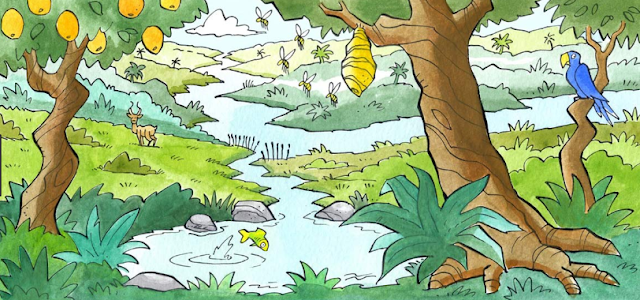Agro ecosystems (Components, Types, Properties)
Definition of Ecosystem
No organism or a species live alone, always there are associates influencing each other and organized themselves into communities. The organism of any community besides interacting among themselves always have functional relationship with the external world or environment. This structural and functional systems of communities and their environment is called ecological system, in short the ecosystem
“Interaction of living organism with environment is known as ecosystem”.
Components of an Ecosystem
There are main 2 components of ecosystem
1. Living (Biotic component)
2. Nonliving (Abiotic component)
1. Biotic component of an Ecosystem
Autotrops and heterotrops are biotic component of ecosystem. Green plants take simple inorganic materials and produce their own foods, This organism are called autotrops. All other form of life which do not possess chlorophyll can’t produce their own foods and depend upon others are known as heterotrops. e.g. Fungi, most of bacteria and animal etc.
2. Abiotic Component of an Ecosystem
Abiotic component are non living environment are usually of 2 types
Materials like water, mineral salts, atmospheric gases etc.
Energy like light, heat, stored energy in chemical bonds etc.
Types of Ecosystem
1. Natural ecosystem
Terrestrial ecosystem Forest, desert, grassland etc.
Aquatic ecosystem Fresh water, ponds, river, lake, marine, mangrove ecosystem etc.
2. Artificial Ecosystem
Agro ecosystem, village ecosystem, town ecosystem etc.
Agro ecosystem
Interactive of agriculture and living organism with environment is called agro ecosystem.
Components of Agro ecosystem
Primary producer: Crops and weeds of the field are the primary producer of agro ecosystem. e.g. In a Rice field, there are many producer like durba, mutha, syma etc also present with rice.
Consumer: Among consumer grasshoppers, aphids, bugs, ants, rats, birds, man etc are macro consumer and frog, snake, hack are micro consumer.
Properties of Agro ecosystem
1. Productivity- It is net increment of values products per unit resources (land, labour, energy, capital) and is commonly measured as annual yield /hectare.
2. Stability It is the degree to which, productivity remain constant, inspite of normal small scale fluctuation in environmental variables such as climate or in the economic condition in market.
3. Sustainability- It is defined as the ability of the system to maintain its productivity when subject to stress or perturbation. A stress is defined as regular, sometimes continues, relatively small and predictable disturbance. e.g. Affect of growing soil salinity. A perturbation by contrast is an irregular, in frequent relatively long and unpredictable disturbance such as drought or flood or a new pest.
4. Equitability- It is a measure of how evenly the produce of Agro ecosystem is distributed among its human beneficial. The more equitable the system, the more evenly are the products to fed shared among the population of the farm, village, regions or nation.
